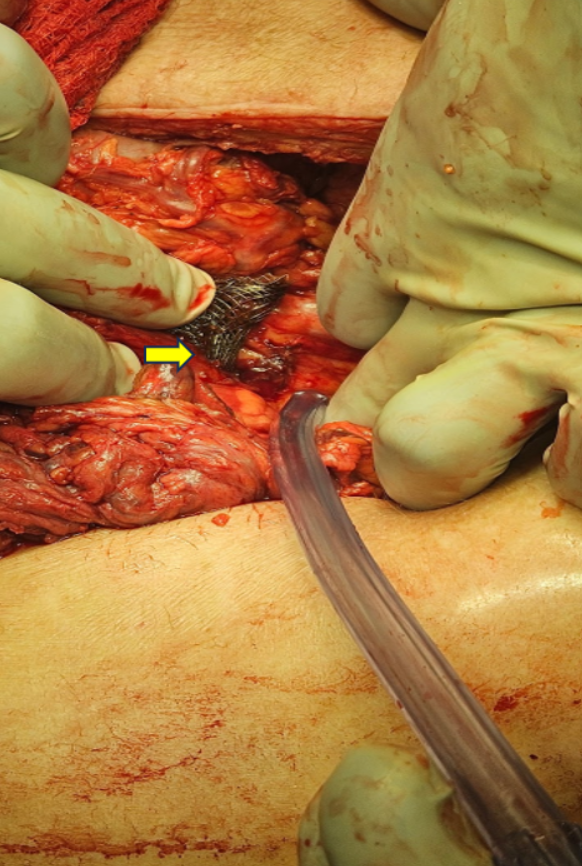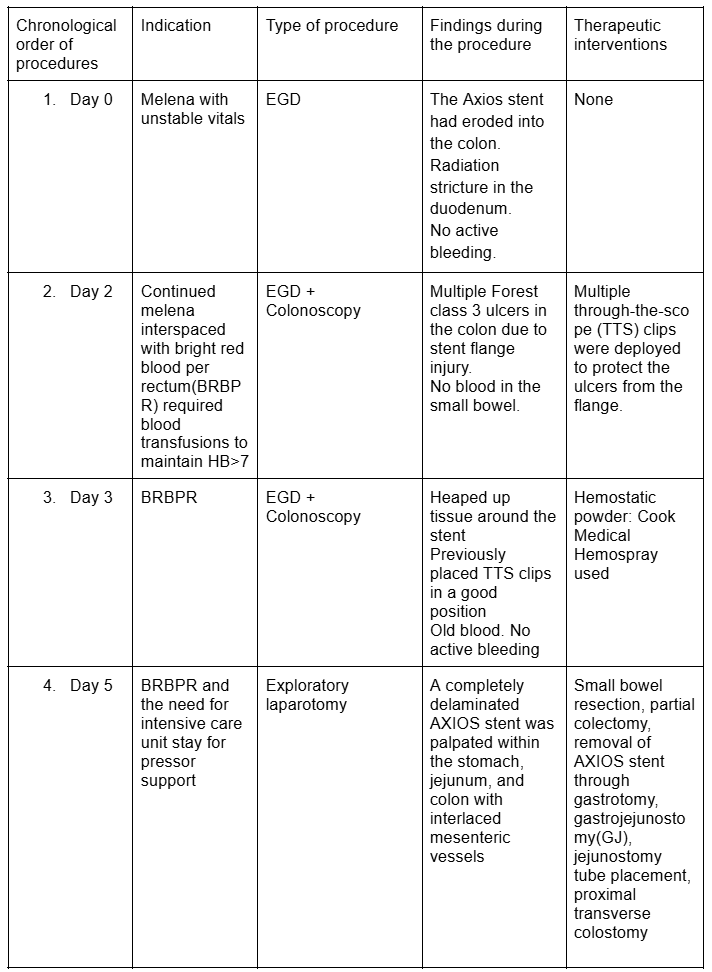Tuesday Poster Session
Category: Interventional Endoscopy
P5724 - Remember to Check on Your Lumen Apposing Metal Stent (LAMS)
Tuesday, October 28, 2025
10:30 AM - 4:00 PM PDT
Location: Exhibit Hall

Rutwik Pradeep Sharma, MD (he/him/his)
University of Michigan-Sparrow Hospital
Lansing, MI
Presenting Author(s)
Rutwik Pradeep. Sharma, MD1, Ryan Law, DO2, Lewis G Sparrow. Rashid, DO1, Abhishek Satishchandran, MD, PhD3
1University of Michigan-Sparrow Hospital, Lansing, MI; 2Mayo Clinic, Rochester, MN; 3University of Michigan-Sparrow Hospital, Ann Arbor, MI
Introduction: The AXIOS LAMS is a silicone-coated , nitinol, self-expanding metal stent, initially designed for the management of pancreatic pseudocysts. LAMS have expanded their role to include transluminal access to abscesses, surgically altered luminal anatomy, and the biliary system. While considerable attention has been given to immediate procedural adverse events (AE) of LAMS placement, such as misdeployment or hemorrhage, delayed AE remain underreported.
Here, we present a case highlighting a delayed AE following the creation of an endoscopic gastroenterostomy (EUS-GE) using a LAMS stent placed to bypass a radiation-induced duodenal stricture in a patient who had prior oncologic treatment.
Case Description/
Methods: Our patient was a 54-year-old male presenting with melena. His past medical history included metastatic adenocarcinoma of the colon, sigmoidectomy, and chemoradiation. His situation was complicated by a radiation-induced duodenal stricture and concern for recurrent malignancy in the midabdomen, causing gastric outlet obstruction. After a multidisciplinary discussion, he underwent a successful EUS-GE with a 20mm x 10mm LAMS without immediate AE. No additional endoscopic evaluation was performed. Eight months later, he was admitted for GI bleeding, secondary to an aortoenteric fistula, and treated with an endovascular graft. Two months later, he presented in hemorrhagic shock due to recurrent GI bleeding. He underwent an emergent esophagogastroduodenoscopy (EGD), revealing that the distal flange of the LAMS had eroded into the colon(Image 1), creating a complex gastro-jejunal-colonic fistula. Tissue ingrowth was visible through the stent walls, confirming delamination of the LAMS. A large amount of old blood was visualized without active bleeding. Multiple additional episodes of GI bleeding occurred without durable endoscopic hemostasis. He ultimately underwent surgical resection of the eroded LAMS with creation of a surgical gastroenterostomy and end-transverse colostomy. He underwent numerous procedures at our hospital, as explained in Table 1. Despite rigorous efforts by multidisciplinary teams, the patient continued to have persistent GI bleeding due to ischemic ulceration of the surgical anastomosis and passed away.
Discussion: Intermittent endoscopic evaluation of LAMS with a dwell time of >6 months may have prevented stent delamination and the described AEs, which occurred in this patient. It is our practice to recommend stent exchange no later than 6 months after initial placement.

Figure: Image 1: Yellow Arrow- The delaminated AXIOS LAMS during surgery

Figure: Table 1: Patient's procedure timeline
Disclosures:
Rutwik Sharma indicated no relevant financial relationships.
Ryan Law: Boston Scientific – Consultant, Grant/Research Support. Neptune Medical – Data Safety Monitoring Board. Olympus – Consultant, Grant/Research Support. UpToDate – Royalties.
Lewis G Rashid indicated no relevant financial relationships.
Abhishek Satishchandran indicated no relevant financial relationships.
Rutwik Pradeep. Sharma, MD1, Ryan Law, DO2, Lewis G Sparrow. Rashid, DO1, Abhishek Satishchandran, MD, PhD3. P5724 - Remember to Check on Your Lumen Apposing Metal Stent (LAMS), ACG 2025 Annual Scientific Meeting Abstracts. Phoenix, AZ: American College of Gastroenterology.
1University of Michigan-Sparrow Hospital, Lansing, MI; 2Mayo Clinic, Rochester, MN; 3University of Michigan-Sparrow Hospital, Ann Arbor, MI
Introduction: The AXIOS LAMS is a silicone-coated , nitinol, self-expanding metal stent, initially designed for the management of pancreatic pseudocysts. LAMS have expanded their role to include transluminal access to abscesses, surgically altered luminal anatomy, and the biliary system. While considerable attention has been given to immediate procedural adverse events (AE) of LAMS placement, such as misdeployment or hemorrhage, delayed AE remain underreported.
Here, we present a case highlighting a delayed AE following the creation of an endoscopic gastroenterostomy (EUS-GE) using a LAMS stent placed to bypass a radiation-induced duodenal stricture in a patient who had prior oncologic treatment.
Case Description/
Methods: Our patient was a 54-year-old male presenting with melena. His past medical history included metastatic adenocarcinoma of the colon, sigmoidectomy, and chemoradiation. His situation was complicated by a radiation-induced duodenal stricture and concern for recurrent malignancy in the midabdomen, causing gastric outlet obstruction. After a multidisciplinary discussion, he underwent a successful EUS-GE with a 20mm x 10mm LAMS without immediate AE. No additional endoscopic evaluation was performed. Eight months later, he was admitted for GI bleeding, secondary to an aortoenteric fistula, and treated with an endovascular graft. Two months later, he presented in hemorrhagic shock due to recurrent GI bleeding. He underwent an emergent esophagogastroduodenoscopy (EGD), revealing that the distal flange of the LAMS had eroded into the colon(Image 1), creating a complex gastro-jejunal-colonic fistula. Tissue ingrowth was visible through the stent walls, confirming delamination of the LAMS. A large amount of old blood was visualized without active bleeding. Multiple additional episodes of GI bleeding occurred without durable endoscopic hemostasis. He ultimately underwent surgical resection of the eroded LAMS with creation of a surgical gastroenterostomy and end-transverse colostomy. He underwent numerous procedures at our hospital, as explained in Table 1. Despite rigorous efforts by multidisciplinary teams, the patient continued to have persistent GI bleeding due to ischemic ulceration of the surgical anastomosis and passed away.
Discussion: Intermittent endoscopic evaluation of LAMS with a dwell time of >6 months may have prevented stent delamination and the described AEs, which occurred in this patient. It is our practice to recommend stent exchange no later than 6 months after initial placement.

Figure: Image 1: Yellow Arrow- The delaminated AXIOS LAMS during surgery

Figure: Table 1: Patient's procedure timeline
Disclosures:
Rutwik Sharma indicated no relevant financial relationships.
Ryan Law: Boston Scientific – Consultant, Grant/Research Support. Neptune Medical – Data Safety Monitoring Board. Olympus – Consultant, Grant/Research Support. UpToDate – Royalties.
Lewis G Rashid indicated no relevant financial relationships.
Abhishek Satishchandran indicated no relevant financial relationships.
Rutwik Pradeep. Sharma, MD1, Ryan Law, DO2, Lewis G Sparrow. Rashid, DO1, Abhishek Satishchandran, MD, PhD3. P5724 - Remember to Check on Your Lumen Apposing Metal Stent (LAMS), ACG 2025 Annual Scientific Meeting Abstracts. Phoenix, AZ: American College of Gastroenterology.
